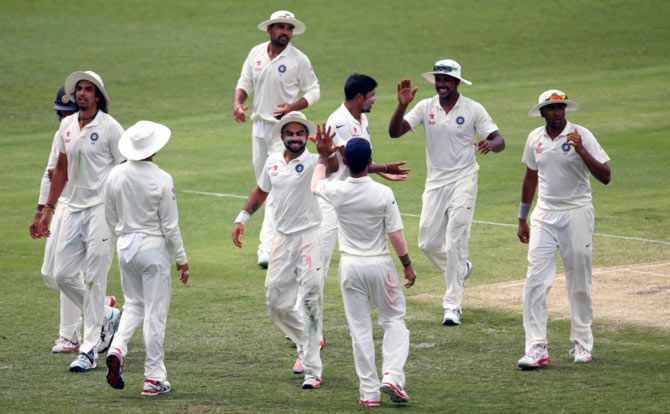
Former captain Anil Kumble believes the mindset of the Indian team management must change and there should be a more flexible approach when selecting bowlers for overseas tours.
- The Rediff Report Card: Who impressed, who failed in Australia
The performance of India's bowlers in the recent four-Test series in Australia, which they lost 0-2, came in for severe criticism, and Kumble feels "some portion of the criticism is justified".
"We have the quality of bowlers; it's just trying to see who can adjust to the Test format and then choosing your best four bowlers who you think can pick up 20 wickets; that's also been an issue," Kumble told ESPNCricinfo on Monday.
He said that there has to be flexibility in selecting the playing eleven when on tour, as it can't work on the theory of three seamers and one spinner in every game.
"We have gone into this theory of three seamers and one spinner the moment we sit on an aircraft which travels more than seven hours - that's the mindset...
"If your 20 wickets are going to come with two spinners and two fast bowlers, so be it. If it comes with three spinners and one fast bowler so be it," India's highest wicket-taker in Test and ODI cricket pointed out.

Citing the example of the Adelaide Test, where on a track known to favour batsmen and assist spinners halfway through the Test, India went in with a single spinner in Karn Sharma.
"So who got wickets for Australia then? If you look at the top two bowlers, it was one spinner and one fast bowler," said Kumble.
- 'India's bowlers lack mental toughness; there is a bit of immaturity'
Australia off-spinner Nathan Lyon was the series' top wicket-taker with 23 victims.
Kumble said an excess of limited-overs' cricket, both ODIs and Twenty20s, has led to the Indian bowlers "not being that disciplined in their approach to bowling when it comes to Tests".
"You are constantly thinking of pre-empting a batsman because you think he will play this shot - that's what you do in one-day cricket. You are always guessing and trying to out-guess the batsman.
"In Test cricket you need to bowl line and length - it is that simple - and keep repeating the same thing. That will only come with playing more of this format, and that will only come with what kind of an approach (you have) prior to heading off (on tour).
"It's the simple thing that needs to be considered. Test cricket is all about building pressure and how you can sustain it; the longer you can sustain the pressure, the more successful you can be," he explained.
The former leg-spinner said India's bowlers have to take more responsibility rather than depend on their captains.
"You can't be looking over your shoulder and ask which ball should I bowl, what field should I set? At the end of the day you know what balls to bowl and what fields to set; you have to be your own captain. You can't be saying, 'Okay, set the field and tell me where to bowl and I will bowl'. That's not how we play cricket. You have to be your own leader."
Insisting that the Board of Control for Cricket in India and team management needs to "monitor its 20 best bowlers", Kumble said, "It is just a matter of managing the top 20 bowlers and trying to follow them during the course of their season, whether they are playing Ranji Trophy or IPL or Test cricket.
"At home they seem fine, they are pretty used to the conditions, but, generally, overseas you need to be stronger."
He was of the view that the bowling attack for Test cricket overseas can be built by studying which of the bowlers have the capacity to be stronger when playing the longer format in away games.
"Not physically stronger, but bowling-wise stronger. People tend to mis-interpret, strength by saying I need to spend time in the gym. That's not strength. You need to sustain yourself for longer when on tour. How long can you bowl? How effective you are in your last spell, whether you are a spinner or a fast bowler. That's what matters in the end."











